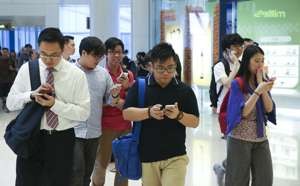
HK shopping malls get creative to replace lost mainland tourists
Activities linked to Pokemon Go prove especially popular, as do more tenants selling family goods
As Hong Kong tourist numbers continue to suffer, particularly from the mainland, shopping mall owners are shifting their attention to younger consumers to maintain rental levels.
The most popular recent promotions have focused on Olympic Games-related activities and Pokemon-themed events, but more tenants offering family products aimed at the affluent have also been encouraged to move into sites.
At Sino Land’s Olympian City in West Kowloon, its second largest shopping mall, the firm has invested HK$8 million in a summer marketing campaign aimed at attracting sales of HK$440 million and a 10 per cent growth in traffic.
“There is strong demand in this district from both families and office workers,” said Ronnie Chan, general manager of Sino Group’s leasing department.
“We do not focus on high-end retail, so we are not that affected by the drop in tourist numbers.”
The falling Chinese visitor numbers have brought down rents on some prime shopping streets.
The latest government data shows visitor arrivals dropped 7.4 per cent in the first half of 2016, and department store sales from January to May were down 8.7 per cent on last year.
Fitch Ratings said in a recent statement that it expects the continued decline in retail sales in Hong Kong to affect shop rentals gradually.

But Olympian City saw its revenue rise about 5 per cent in the first half to HK$1.3 billion, according to Chan, and she is expecting another increase in the second half.
And what’s made the difference, she said, is the mall is attracting young middle class shoppers by bringing in retailers selling health and children’s products.
“About 75 per cent of people in the Olympics district work at management level,” Chan said.
“And many parents here pay great attention to children’s growth. We cater to the needs of this community.”
Houseware brand Muji opened its Olympian City store on Monday, with its first book section in Hong Kong offering a collection ranging from Italian cooking guides, to brochures on Japanese-style home design.
Dora Hung, general manager of Muji Hong Kong, said although revenue growth in the city has slowed from double to single-digit percentage, strong local demand is keeping sales robust.
“We are less hurt than some big retailers,” Hung said. “The good thing is we mainly serve local consumers.”
Take a walk in any busy area of Hong Kong at the moment, meanwhile, and Pokemon Go fever is strong in many parts of the city.
With this in mind, Sino Land managed to record footfall growth of about 5 per cent since it started using Lure Module in its shopping malls, a virtual item that generates more Pokemon in certain places.
Landlords including Wharf (Holdings), Swire Properties and Sun Hung Kai Properties have also been tapping into the popular mobile game to bring back local customers.

